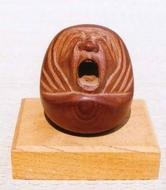:::::::::::::::::::::::::::::::::::::::::::::::::::::::::::::::::::::::::::::::::::::::::::::::::::::
Fudo Myo-O Gallery
:::::::::::::::::::::::::::::::::::::::::::::::::::::::::::::::::::::::::::::::::::::::::::::::::::::
Seated Fudo Myoo
Museum Rietberg Collection
Quote from : Orientations, Volume 38 - Number 2 - March 2007
Japan, Fujiwara period, second half of 12th century
Cypress wood with traces of polychrome decoration
Height 112 cm, width 42 cm

(© Photography by Rainer Wolfsberger)
A Short History of the Museum Rietberg Zurich
by Helmut Brinker, Professor Emeritus of the University of Zurich.
The author introduces the major holdings in the museum and the donors including the initial founder Baron Eduard von der Heydt who presented his extensive Asian art collection to the city of Zurich in 1952. Of paramount importance to him was the noble human images rendered most convincingly in sculptures of deities from the Buddhist and Hindu pantheons. Brinker discusses von der Heydt's acquisition policy and how he loaned during World War II entire collections to various institutions including to museums in the US which, to this day, have not been returned.
The von der Heydt collection was supplemented by the J.F.H. Menten collection of Chinese tomb sculpture when the Museum Rietberg was established and many other collectors of Asian art followed van der Heydt's example and entrusted their treasures to the museum. For example, the Japanese woodblock print collections of Willy Boller and Heinz Brasch were gifted by Julius Mueller; in 1971 Alice Boner donated her collection of Indian art and the collection of Chinese paintings assembled by Charles A. Drenowatz was the most significant donation in the period from 1970 to 1982.
During the 1980s Ernst Winkler bequested 43 archaic Chinese bronzes and Pierre Uldry's unique collection of Chinese cloisonne and gold and silver are also on view in the new galleries. No masks were given to the museum by Nanni and Balthasar Reinhart and the collection of Himalayan and Tibetan art has been enriched by Berti Aschmann's collection of gilt-bronze Buddhist sculptures.
© PHOTO and Text
www.orientations.com.hk
Ema Votive tablet from the Rietberg Museum
:::::::::::::::::::::::::::::::::::::::::::::::::::::::::::::::::::::::::::::::::::::::::::::::::::::
Helmut Heinrich Brinker
* 17. August 1939 in Lübbecke, Westfalen;
† 9. Juli 2012 in Langnau am Albis, Schweiz;
war ein deutsch-schweizerischer Kunsthistoriker und Sinologe.
Brinker studierte die Kunstgeschichte Ostasiens und abendländische Kunstgeschichte sowie Sinologie und Japanologie an den Universitäten Heidelberg, Harvard und Princeton. Er war Stipendiat der Studienstiftung des deutschen Volkes und hatte den Harkness Fellowship des Commonwealth Fund in New York inne. 1970 wurde er an der Ruprecht-Karls-Universität Heidelberg promoviert. Von 1970 bis 1982 war er Kurator am Museum Rietberg in Zürich und zuständig für die Oastasienabteilung.
Ab 1970 war er an der Universität Zürich tätig, zunächst als Lehrbeauftragter und Privatdozent. 1978 wurde Brinker als Extraordinarius und 1982 als Ordinarius für Kunstgeschichte Ostasiens an der Universität Zürich bestellt. Er galt als Experte für die Kunst des Zen-Buddhismus.
Brinker veröffentlichte zahlreiche wissenschaftliche Arbeiten und Bücher, darunter Zen in der Kunst des Malens (1985) und ZEN: Meister der Meditation in Bildern und Schriften (1993).
© More in the WIKIPEDIA !
Seckel, Ledderose and Brinker - Photo
. Prof. Dr. Dietrich Seckel .
:::::::::::::::::::::::::::::::::::::::::::::::::::::::::::::::::::::::::::::::::::::::::::::::::::::
Zaigai Hihô - Hidden Treasures Outside East Asia
Zaigai Hiho
source : c.zaigai-hiho.net
:::::::::::::::::::::::::::::::::::::::::::::::::::::::::::::::::::::::::::::::::::::::::::::::::::::
[ . BACK to DARUMA MUSEUM TOP . ]
[ . BACK to WORLDKIGO . TOP . ]
:::::::::::::::::::::::::::::::::::::::::::::::::::::::::::::::::::::::::::::::::::::::::::::::::::::






No comments:
Post a Comment